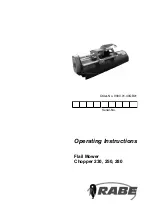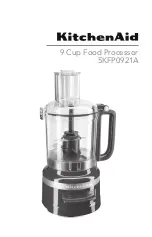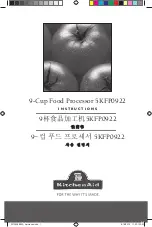
- 8 -
08/2019
Copyright © 2019, Fast ČR, a.s.
Rice flour
It is made from rice and is used to make the texture of baked goods finer, for example
for shortcrust pastry.
BAKING POWDER
It is used as a leavening agent in baking.
BAKING SODA
It is known as sodium bicarbonate. It can be used as an additional leavening agent or
for darkening certain baked goods.
BUTTER
It provides a specific taste and a fine texture to baked goods. In certain recipes it is
possible to substitute oil for butter, however the resulting taste and texture of the baked
good will be different. In this case, use ¼ less butter than the amount of oil indicated
in the recipe. Before you start whipping butter together with sugar, allow it to soften
at room temperature.
EGGS
Eggs should be at room temperature to give the correct volume to baked goods. Crack
the eggs individually into a separate bowl and only then add to the other ingredients. This
will prevent ruining the entire batch if one of the eggs is rotten. If you will be whisking
the egg whites, carefully separate them from the yolks. Egg yolks contain fat and their
remains prevent the successful whipping up of egg whites. Before you start whipping
the egg whites, make sure that the whisk and the mixing bowl are completely clean
and without fat residues. Otherwise, the egg whites might not be perfectly whipped.
MILK
Full-cream milk should be used unless indicated in the recipe otherwise. Low-fat or
half-cream milk can be used but the final taste and texture of the baked goods may
be different.
SUGAR
Usually white granulated sugar is used. It adds flavour, texture and colour to baked goods.
Caster sugar is also frequently used because it dissolves easier when it is whipped with
butter. Brown sugar may be used to add a different taste and colour to the baked goods.
BAKING
■
Allow the oven to preheat to the correct temperature before starting baking.
■
The baking temperature may differ depending on the type of baking oven. Reduce the
temperature indicated in the recipe by 15–20 ˚C if using a hot-air oven.
■
Instead of floured baking pans and trays, you can use parchment paper if appropriate.
You can coat the baking pan with a small amount of fat to prevent the parchment
paper from sliding on the smooth surface of the baking pan.
■
Test that the baked good is finished before taking it out of the oven. Gently touch the
top of the baked good, if it returns to its initial shape, it should be properly baked.
Carefully insert a skewer into the middle of the baked good and pull it out. If the
dough does not stick to the skewer, the baked good is finished.
■
To make biscuits crispier, take the baking tray out of the oven and place it onto a metal
rack. Move the individual items on the baking tray from their baking location and allow
them to cool down. Once they cool down move them from the baking tray to a platter.
RECIPES
Sponge cake
4 eggs, separated egg whites from yolks
¼ of a cup of caster sugar
1 cup (150 g) of medium-fine flour with baking powder, sieved
3 tablespoons of water
■
Use the elastic balloon whisk
A2
.
■
Set the speed level to 6 and whisk up the egg whites into a thick foam. Reduce the
speed level to 1 and slowly add sugar until the foam thickens and stops to be smooth.
■
Add the egg yolks and mix carefully.
■
Set the speed level to 1 and intermittently add flour and water. Whisk until the
ingredients combine.
■
Pour the dough into a pre-prepared greased and floured baking pan.
■
Bake in a preheated oven at 180 °C for approx. 20–25 minutes.
■
Allow the baked sponge cake to cool down on a metal rack.
Vanilla batter dough cake
125 g of butter, softened
¾ of a cup of caster sugar
1 teaspoon of vanilla essence
2 eggs
2 cups (300 g) of medium-fine flour with baking powder, sieved
¾ of a cup of milk
■
Use the A-shaped beater
A3
.
■
Set the speed to 6 and beat the butter together with sugar until the mixture is fluffy
and smooth.
■
Add the vanilla essence, eggs one after the other and beat them thoroughly.
■
Reduce the speed to 2 and slowly intermittently add flour and milk and beat until
a smooth dough forms.
■
Pour the dough into a pre-greased and floured baking pan with a diameter of 22 cm.
■
Bake in a preheated oven at 180 °C for approximately 45–50 minutes or until the
dough is golden in colour.
■
Allow the baked cake to cool down on a metal platter.
Butter biscuits (approx. 40 pcs)
125 g of butter, softened
¾ of a cup of caster sugar
1 teaspoon of vanilla essence
1 eggs
2 cups (300 g) of medium-fine flour
1 teaspoon of baking powder
■
Use the A-shaped beater
A3
.
■
Set the speed to 6 and beat the butter until smooth. Add sugar, vanilla essence and
the egg. Beat until a light smooth mixture is created.
■
Mix the flour and the baking powder.
■
Set the speed to 2 and gradually add the flour until everything is properly combined
into a single mass. Do not, however, beat for too long.
■
Use a teaspoon to form small balls and lay them out evenly on to a lightly greased or
parchment paper covered baking tray. Leave sufficient room around each ball. Using
a lightly floured fork, push down each of the balls.
■
Bake in a preheated oven at 190 °C for approximately 12–15 minutes or until the
biscuits are lightly golden in colour.
■
Take the biscuits off the baking tray and leave to cool down on a metal rack.
Cream snow puffs (20–24 pcs)
4 egg whites
1 cup of caster sugar
■
Use the elastic balloon whisk
A2
.
■
Set the speed level to 6 and whip up a thick snow from the egg whites. Lower the speed
to level 1 and carefully add half the sugar and whip it in. Then add the remaining sugar.
■
Using a spoon, apply a small amount of the snowy mixture on to a lightly greased
baking tray. Leave about 3 cm around the individual pieces so that they do not bake
to one another.
■
Bake in the oven at 120 °C about 1 to 1½ hours or until the snow puffs are dry. To avoid
burning them, do not, however, bake then too long. Take them off the baking tray and
put them aside to cool down and store them in an air-tight container.
Note:
You can use a decorating tool to create larger snow puffs. This may necessitate a longer
baking time.
White bread
4 cups (600 g) of bread flour
3 tablespoons of dried milk
1½ teaspoons of salt
1½ tablespoons of sugar
1 teaspoon of bread improver
2 teaspoons of instant yeast
2 tablespoons of oil
1½ cups (375 ml) of water
additional bread flour for hand kneading
■
Use the kneading hook
A1
.
■
In the mixing bowl, mix the flour, dried milk, salt, sugar, bread improver and the
instant yeast.
■
Set the speed to 1–2 and slowly add water and oil into the dry mix. Leave it to knead
until a dough starts to form.
■
Move the dough on to a lightly floured rolling board and thoroughly knead by hand
until the dough is sufficiently fine and smooth.
Note:
At this stage, the dough should be very well kneaded so that gluten is
formed, which gives the dough the correct elasticity and helps it to rise.
■
Place the dough into a large bowl and cover with plastic wrap. Allow it to rise in a warm
place for about 20 minutes or until the dough doubles in size.
■
Take the risen dough out of the bowl and knead once more on a lightly floured
rolling board.
■
Place the dough into a baking pan. Cover with plastic wrap and allow it rise in
a warm place for about 30–40 minutes or until the dough has risen sufficiently.
Remove the plastic wrap.
■
You can apply an egg glaze before baking. Bake in a preheated oven at 200 °C for
approximately 40–50 minutes or until the bread is golden in colour.
■
Allow the baked bread to cool down for 15 to 20 minutes and then remove it from
the baking pan. Allow the loaf to cool down completely before cutting it, to prevent
it from collapsing.
Egg glaze for bread dough
1 egg, lightly beaten
2–3 tablespoons of water



























